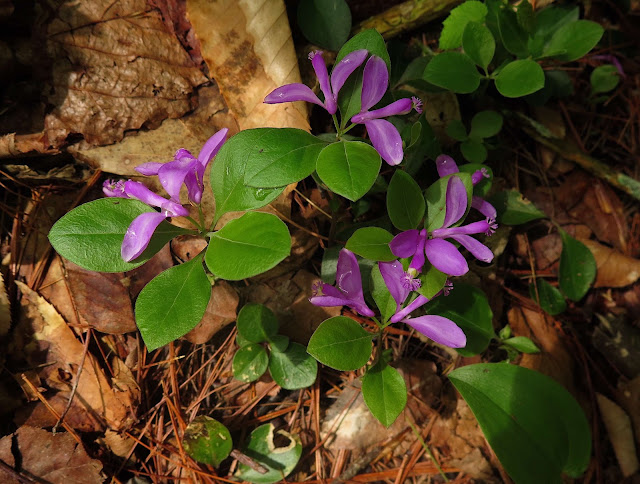Oh gosh, but I must get back to my blog! It's not that I don't have much to report (Hah! Not likely, this burgeoning time of year!), it's just that I've been distracted by other concerns, like my daughter's illness and the death of a dear friend, and I just couldn't think of other things but those. Let me remedy this blogging hiatus by reporting on a lovely day tromping about in a small swamp along the road that climbs and descends Mt. McGregor in Wilton. My visit there was over a week ago.
This little swamp is lush and shady and green, with pools of standing water occupied by cattails and ferns and mosses and violets and -- here's why I always come here -- ORCHIDS!
And there they were! Lots of the small orchid called Early Coralroot (Corallorhiza trifida) emerging right at the edge of shallow moss-crowded water, the bright-yellow blooms so evident against the dark green of the Sphagnum. It's a good thing the flowers are so bright, or I'd never espy them among the surrounding greenery, they are so small.
Here's a closer look at Early Coralroot's inflorescence.
The leafless yellow-flowered Early Coralroot has enough green to it to obtain some nutrients via photosynthesis (even here in such deep shade), but it is also a saprophyte, obtaining most of its nutrients from decaying organic matter through a parasitic relationship with a fungal mycelium. A self-pollinating orchid, it doesn't depend on attracting insects to carry off its pollinia to neighboring plants, but it definitely was brightly colored enough to attract my attention, despite being quite tiny. Growing in a populous cluster of plants certainly made it easier to see.
How appropriate to find the Swamp Jack-in-the-pulpit (Arisaema stewardsonii) in this little swamp. Among the features that distinguish this species are the raised white ridges of the spathe. It also tends to be on the smaller size than the more common Jack (A. triphyllum). Some taxonomists consider this plant as a subspecies of A. triphyllum, but others, including those in New York State, consider the Swamp Jack to be a species in its own right. It grows only in soils that are damp.
There were many other beautiful shade-loving flowers abloom this day in the drier soils of the woodland surrounding this swamp. None was more colorful than the rose-purple flowers of Fringed Polygala (Polygaloides paucifolia), spreading across the forest floor.
Rivaling the Fringed Polygala for beauty was the elegant Starflower (Lysimachia borealis). Many I found bore two or three flowers on thread-fine stalks, but I particularly loved the stunning simplicity of this single bloom, startling in its pure whiteness against the rough dark bark of a fallen tree.
Most of the abundant little flowers called Goldthread (Coptis trifolia) were past their prime by now, but I did find this one still fresh enough to display its very unusual-looking parts. What look like white petals are actually the sepals, with the petals being those tiny translucent yellow growths that look like lemon lollipops. In the center emerge the spindle-shaped green pistils that end with a sharply curled hook, and they are surrounded by many slender white stamens. The plant's three-parted evergreen leaves are out of focus but still evident in this photo.
And here was the queen of the forest-floor flowers, a single Painted Trillium (Trillium undulatum)! Its rose-splashed white petals were illuminated by a stray ray of sunlight that found its way through the forest canopy to spotlight the rare beauty of this flower.
As we made our way around the wetter parts of the swamp, we discovered masses of small white violets thickly covering hummocks that were surrounded by standing water.
Which species is this white violet? To tell the truth, I am never sure about these small white basal-leaved violets. I will hazard a guess, though, based on the saturated soil and the rounded, blunt-tipped leaves, that these are the Northern White Violets (Viola pallens), known for liking it wet. Which it certainly was, here.
There was one other violet here that also likes its feet wet, the Marsh Blue Violet (Viola cucullata), a tall blue-flowered species that often shares its soggy soils with the bright-yellow blooms of Marsh Marigold (Caltha palustris).
Another interesting water-lover here was this tiny fungus, glowing orange globs atop translucent stalks rising from very wet mud. Called Bog Beacons (Matrula paludosa), this is a saprotrophic fungus, a recycler of dead plant material, and is only found in very wet habitats like mud or very shallow water.
Continuing on over Mt. McGregor to Spier Falls Road, I pulled over in a trailhead parking area to visit a particular patch of Foamflower (Tiarella stolonifer) I hoped would be blooming by now. And so it was, the spikes of its starry white flowers perfectly silhouetted against the dark shade of the background forest. The flower stalks reminded me of the sparklers we used to light on the Fourth of July.

Just across Spier Falls Road from that Foamflower patch is a trail that leads down to the Hudson River banks. I searched along that trail for the Painted Trillium flower I'd found there a week before, and indeed I found it. It wasn't in the glory of bloom it had displayed when last I saw it, though. Ah, but it now displayed a very different kind of beauty, its fading petals now nearly translucent and sharply recurved, the previous splash of rose in the center now evolved into delicate striping. And rising from the center of the flower, the green beginnings of what will be a bright red fruit.













Well, at least I can say most of those are familiar!
ReplyDeleteElyn Hiscox
ReplyDeleteSorry for the hard parts, but thanks for sharing your beautiful walk. I think of you often as I wander out birding...so many plants that I can't identify. Hugs
ReplyDelete